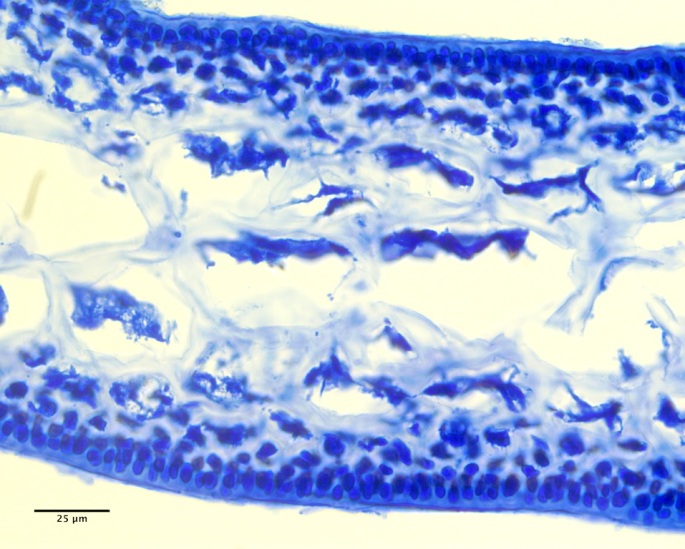Thalli consist of clumps of individual fronds, ranging in size from 1-17 cm tall (smaller individuals have been field identified as Erythrodermis traillii (Holmes ex Batters) Guiry & Garbary), that have terete stipes below, which account for 20-50% of the overall height of each frond (Image A). In this species the apparent flattened portions of the stipes are typically clearly the remnants of eroded blades, which produce young blades from their apices yielding compound thalli (Image B). Terminal bladed portions are highly variable in shape and size. In transverse section near their apices the bladed regions are 120-200 µm thick consisting of 3-6 layers of variable (30-90 µm; the largest typically axially compressed, i.e. wider than tall) medullary cells that gradually reduce in size to a 1-2 layered inner cortex and ultimately an outer cortex of 2-3 layers lacking an anticlinal appearance (Image C). Terete regions of the stipe are 400-800 µm wide and composed of many layers of medullary cells that are variable in size, typically 10-35 µm in diameter, and surrounded by a relatively thick cortex of anticlinally arranged cells (Image D). This species reproduces by the production of carpotetrasporangia formed in cystocarps on the gametophyte generation (a free living sporophyte generation is lacking in the life history) at the termini of the blades (Image E).
We have genetically verified records from mid intertidal pools to the subtidal (22 m) ranging from Nome Alaska to Gloucester, MA, as well as from Norway. In general terms Coccotylus brodiei (Turner) Kützing is more common to the south in the NW Atlantic while Coccotylus truncatus extends through the Canadian Arctic into the Bering Sea preferring northerly waters and being typically subtidal in its southern range. The stipes in Coccotylus brodiei (Turner) Kützing also contribute more (50-70%) to the overall length of individual fronds than in Coccotylus truncatus (20-50%). Definitive identification requires molecular work. Although less likely for Coccotylus truncatus than C. brodiei, species of Coccotylus are easily confused with some individuals of Phyllophora pseudoceranoides (S.G.Gmelin) Newroth & A.R.A.Taylor, but stipes in the latter are typically terete throughout their length only expanding as they form the cuneate bases of the blades and they typically account for 70-90% of the overall height of individual fronds. Further, cystocarps in Phyllophora pseudoceranoides (S.G.Gmelin) Newroth & A.R.A.Taylor are formed along the stipe, not at the blade termini, and contain carposporangia, while the tetrasporangia are formed in sori on a separate diploid generation, i.e. there is an alternation of isomorphic generations. Coccotylus spp. form carpotetrasporangia lacking a separate sporophyte generation. Vegetative individuals of intermediate morphology should be confirmed with molecular data. This species can be highly variable in morphology, some of which is recorded in the BOLD taxonomy browser.
 Image A. Subtidal (22 m) specimen from Naufrage, PE (GWS041459).
Image A. Subtidal (22 m) specimen from Naufrage, PE (GWS041459).
 Image B. Blades regenerating from the eroded margin of an older blade (arrow) in a subtidal (13 m) specimen from Churchill, MB (GWS005394; press). Scale = mm ruler.
Image B. Blades regenerating from the eroded margin of an older blade (arrow) in a subtidal (13 m) specimen from Churchill, MB (GWS005394; press). Scale = mm ruler.
 Image C. Transverse section near the tip of the bladed portion of an axis from a subtidal (8 m) specimen from Gloucester, MA (GWS014766; rehydrated from press; aniline blue stained).
Image C. Transverse section near the tip of the bladed portion of an axis from a subtidal (8 m) specimen from Gloucester, MA (GWS014766; rehydrated from press; aniline blue stained).
 Image D. Transverse section mid way along a terete stipe (GWS014766; rehydrated from press; aniline blue stained).
Image D. Transverse section mid way along a terete stipe (GWS014766; rehydrated from press; aniline blue stained).
 Image E. Carpotetrasporangial cystocarps (arrow) on a pressed subtidal (6 m) specimen from northern Baffin Island, NU (GWS001851). Scale = mm ruler.
Image E. Carpotetrasporangial cystocarps (arrow) on a pressed subtidal (6 m) specimen from northern Baffin Island, NU (GWS001851). Scale = mm ruler.
